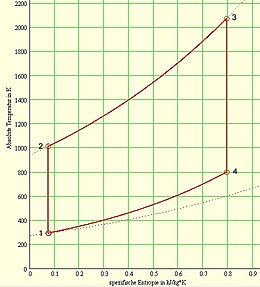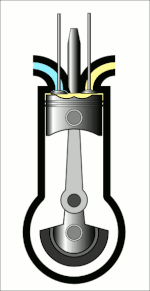Equal pressure process

The constant pressure process (also called the diesel cycle process for piston engines) is a comparison process for machines in which the heat is supplied at constant pressure. ( Isobaric ; in piston engines after top dead center at the beginning of the expansion). These stands in contrast to the constant-volume process (also called Otto cycle) in which the heat is supplied at constant volume ( isochoric , with piston engines at top dead center).
Technically, real engines mostly work in the transition area between the ideal constant space and constant pressure process, for which the mixed Seiliger cycle process in particular provides a better approximation, which can be used for both diesel and gasoline engines.
Ideal equal pressure process
| Thermodynamic state diagrams of an ideal constant pressure process ( diesel cycle ) | |
|---|---|
The theoretically ideal equal pressure process does not include chemical conversion ( combustion ) or gas exchange with the emission of exhaust gas and strictly consists of four changes of state of an ideal gas within a closed system :
- 1➝2: isentropic compression
- 2➝3: isobaric heat supply (therefore equal pressure process)
- 3➝4: isentropic expansion
- 4-1: isochoric pressure reduction through heat dissipation (practical in engines with internal combustion through gas exchange, i.e. expelling the exhaust gas and sucking in a fresh gas charge)
The area enclosed by the line 1-2-3-4 in the pV diagram corresponds to the specific process work w .
Thermal efficiency in the equal pressure process
The efficiency of the equal pressure process (diesel process) depends on:
- ; Geometric compression ratio (maximum value of the combustion chamber for pistons at BDC / smallest value of the combustion chamber for pistons at TDC)
- ; Full pressure or equal pressure or injection ratio
- ; Isentropic coefficient of the working gas. This coefficient would be 1.4 for air at normal temperature. Exhaust gas or fuel gas has a value of about 1.3 due to its changed composition and high temperature. C is the heat capacity in J / K and c is the specific heat capacity in J / (kg K).
-
; The equal pressure ratio depends on the heat supply. The greater the amount of heat, the lower the efficiency!
- : Basic temperature (K). For example 400 K (approx. 127 ° C) before the compression stroke in the cylinder.
- : supplied specific heating energy (J / kg). For example 42,000 J / kg for diesel.
- : specific heating mass per fuel mass (kg / kg). For example 21 kg of air and residual exhaust gas per kg of diesel.
- : specific heat capacity of the exhaust gases or combustion gases in J / (kg K). For example 1.2 J / (kg K).
The derivation for the efficiency formula is as follows:
The isobaric amount of heat supplied in joules is:
- or in Newton meters
The amount of isochoric heat dissipated is:
- or
The energy loss factor is:
Using the polytropic equation, it follows:
The thermal efficiency is:
Comparison of the efficiency of constant pressure and constant space processes
The first factor on the right of the equation corresponds to the loss of efficiency of the constant space process. The second part is the additional efficiency reduction factor (> 1 compared to the constant space process).
With the same compression ratio , the constant pressure process has, in purely mathematical terms, a worse thermal efficiency than the ideal constant space process . From a technical point of view, however, the diesel cycle process in modern engines in particular is easier to control than the constant -space process (especially the Otto cycle process ), so that in practice it ultimately achieves a better degree of efficiency with higher-tolerance process parameters .
Diesel cycle
Supplemented by a charge exchange with internal combustion and emissions of exhaust gas of the direct printing process is for piston engines than diesel cycle , respectively. This includes both two-stroke - as well as four-stroke - piston engines whose stroke of a respective piston stroke or half a crankshaft revolution there. The conditions are in principle applicable to rotary piston engines and rotary engines .
The ideal diesel engine
The theoretically ideal diesel engine has no dissipation losses, mechanical friction losses, auxiliary units, cylinder cooling or leakage losses. The working gas has the same properties over the entire cycle and no flow losses. The ideal charge exchange takes place without mixing fresh charge with exhaust gas.
For the four-stroke diesel engine, the curves in the status diagram can be assigned to the 4 work cycles as follows ( the numbering in the status diagram should not be confused with the work cycles! ):
- "Suction" cycle (0-1): Filling with air as a fresh charge
- "Compression" cycle (1➝2): isentropic strong compression until the ignition temperature is reached at top dead center ignites the injecting fuel ( self-ignition )
- "Expand" cycle: first (2➝3) isobaric expansion during the supply of heat through continued constant pressure combustion, then (3➝4) isentropic expansion of the hot exhaust gas continues to work
- "Push out" cycle (4➝1): Deviating from the ideal constant pressure process, there is now no isochoric pressure reduction through heat dissipation at bottom dead center, but the heat is released from the working chamber by opening the exhaust valve with the exhaust gas , with the residual pressure dynamically expanding into the exhaust . The remaining exhaust gas is then expelled by the piston stroke (10).
While the four-stroke cycle requires a complete crank rotation with 2 working cycles for the gas exchange, the two-stroke engine does this very quickly while passing through the bottom dead center, so that the working cycles "suction" (0-1) and "exhaust" (1-0 ) simply omitted. The technical processes of the gas exchange are not shown in the thermodynamic state diagram for the ideal constant pressure process, where they practically accumulate in point 1.
| State diagram for a real four-stroke diesel engine | |
|---|---|
The real diesel engine
The state changes in the real diesel engine deviate considerably from the course of the theoretical ideal diesel cycle process :
- The fuel-air mixture is not an ideal gas , but has a smaller isentropic exponent and increases its heat capacity at high temperatures. In addition, the combustion changes the material composition, the heat capacity of the working gas. The reaction products water vapor and carbon dioxide have different thermodynamically relevant properties than oxygen and fuel.
- Isobaric heat supply is practically only approximately achieved, since the combustion process (temporal mixing and combustion of the fuel with the air) is not precisely adapted to the working space that changes with the crank movement : As in the Otto engine, the diesel engine also leads shortly before top dead center the beginning of the supply of heat leads to a further increase in pressure, so that the maximum pressure rises well above the compression pressure.
For these reasons, the constant pressure process or the diesel cycle process has little predictive power for real engines. The mixed Seiliger cycle , which can be used for both diesel and gasoline engines, provides a better approximation than constant space and constant pressure processes .
Time-controlled fuel injection ( multiple injection in common rail engines) can also influence combustion in order to avoid excessively high temperatures and pressures.
Real motor losses
Compared to the comparison process, the real cycle process in the engine does less work:
- The gas exchange with suction and discharge is comparable to a pumping process, which consumes a certain part of the engine power due to friction and flow losses (gas exchange work = counterclockwise loop between 0 and 1 in the pV diagram).
- Some of the thermal energy is lost on the combustion chamber surfaces and does not contribute to the work performance. (The losses due to incomplete combustion and the endothermic formation of nitrogen oxides are not recorded in the comparison process)
- Since releasing the outlet cross-section also takes some time, the outlet valve opens shortly before bottom dead center, so that the process area is cut in point 4 (loss of expansion): The residual pressure of typically around 3-5 bar "fizzles out" into the exhaust system , if not yet used by an exhaust gas turbine whose further expansion is used.
The ratio of the work released in the engine to the theoretical work of the cycle is called the quality level. Real motors also have a mechanical power loss due to friction, auxiliary drives and auxiliary drives, which can amount to more than 10% of the nominal power and reduce the efficiency , especially at part load.
Technical efficiencies in the diesel cycle
The main thermodynamic loss occurs in the diesel cycle , as in the Otto cycle , through unused exhaust gas heat and residual exhaust pressure (typically 3-5 bar), which in the simple naturally aspirated engine is released unused into the exhaust . More effective is the further expansion of the residual pressure in an exhaust gas turbine , the power gained is preferably transferred to the crankshaft via a turbocharger when the compressed charge air drives the piston in the intake cycle instead of having to work against negative pressure as in the naturally aspirated engine. In large diesel engines, exhaust heat can be used in a waste heat boiler to operate a steam turbine .
Diesel engines with turbochargers and charge air cooling achieve efficiencies of up to 42% for cars, 45% for trucks and over 50% for large marine diesel engines , which are similarly used in combined heat and power plants .
The exhaust gas heat has a larger share than the heat dissipation through air or water cooling. Both heat flows can be used equally for heating purposes, especially in stationary systems such as combined heat and power plants, but also on ships or for motor vehicles that have a significant heating requirement due to poor body insulation, especially in winter.
See also
literature
- Literature on technical thermodynamics
- Wolfgang Kalide: Pistons and flow machines. 1st edition, Carl Hanser Verlag, Munich / Vienna 1974, ISBN 3-446-11752-0 .
- Jan Drummans: The car and its technology. 1st edition, Motorbuchverlag, Stuttgart 1992, ISBN 3-613-01288-X .
- Karl-Heinz Dietsche, Thomas Jäger, Robert Bosch GmbH: Automotive pocket book. 25th edition, Friedr. Vieweg & Sohn Verlag, Wiesbaden 2003, ISBN 3-528-23876-3 .























